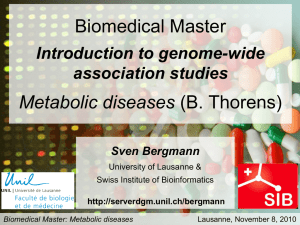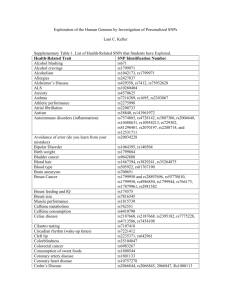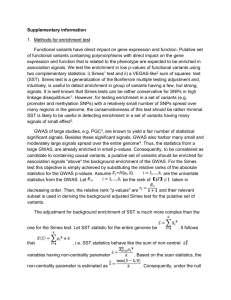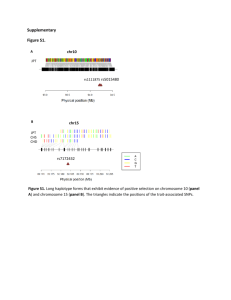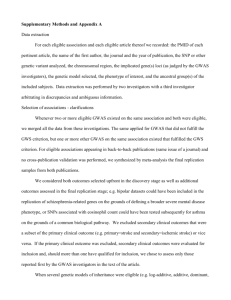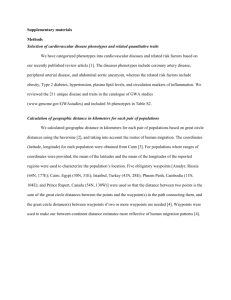Genetic association study between the detected risk variants based
advertisement
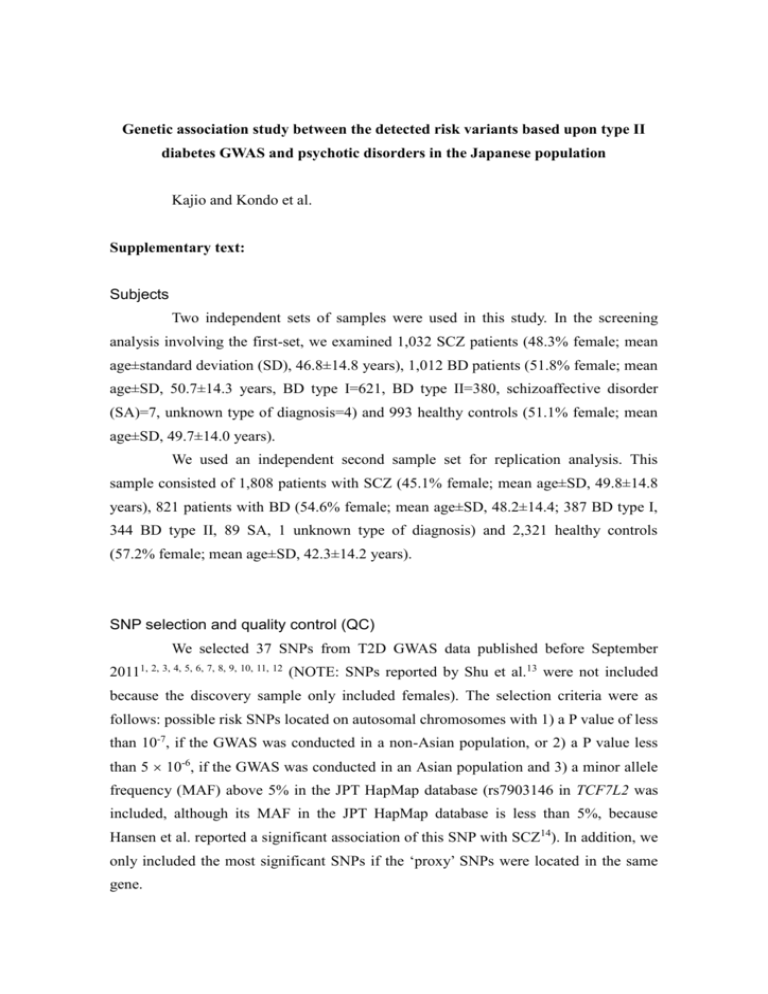
Genetic association study between the detected risk variants based upon type II diabetes GWAS and psychotic disorders in the Japanese population Kajio and Kondo et al. Supplementary text: Subjects Two independent sets of samples were used in this study. In the screening analysis involving the first-set, we examined 1,032 SCZ patients (48.3% female; mean age±standard deviation (SD), 46.8±14.8 years), 1,012 BD patients (51.8% female; mean age±SD, 50.7±14.3 years, BD type I=621, BD type II=380, schizoaffective disorder (SA)=7, unknown type of diagnosis=4) and 993 healthy controls (51.1% female; mean age±SD, 49.7±14.0 years). We used an independent second sample set for replication analysis. This sample consisted of 1,808 patients with SCZ (45.1% female; mean age±SD, 49.8±14.8 years), 821 patients with BD (54.6% female; mean age±SD, 48.2±14.4; 387 BD type I, 344 BD type II, 89 SA, 1 unknown type of diagnosis) and 2,321 healthy controls (57.2% female; mean age±SD, 42.3±14.2 years). SNP selection and quality control (QC) We selected 37 SNPs from T2D GWAS data published before September 20111, 2, 3, 4, 5, 6, 7, 8, 9, 10, 11, 12 (NOTE: SNPs reported by Shu et al.13 were not included because the discovery sample only included females). The selection criteria were as follows: possible risk SNPs located on autosomal chromosomes with 1) a P value of less than 10-7, if the GWAS was conducted in a non-Asian population, or 2) a P value less than 5 10-6, if the GWAS was conducted in an Asian population and 3) a minor allele frequency (MAF) above 5% in the JPT HapMap database (rs7903146 in TCF7L2 was included, although its MAF in the JPT HapMap database is less than 5%, because Hansen et al. reported a significant association of this SNP with SCZ14). In addition, we only included the most significant SNPs if the ‘proxy’ SNPs were located in the same gene. All of the SNPs were genotyped using the Sequenom iPLEX GOLD system (Sequenom, San Diego, CA). In the optimization step, we designed primers for all of the SNPs and verified the genotype clustering. Four SNPs did not show acceptable genotyping calls, and we designed new primers for proxy SNPs (N=4) to replace these SNPs. Thus, we determined the genotype distribution for a total of 37 SNPs in the final genotyping stage (Supplementary Table 1). The quality control (QC) procedures were based on the missing rate per person (less than 10%) and per SNP (less than 5%) and the existence of Hardy-Weinberg Equilibrium (HWE) with a P value of more than 0.0001 by visual inspection. Polygenic component analysis and sign test To increase the statistical power for our results in the first-set screening samples, we conducted a polygenic component analysis proposed by International Schizophrenia Consortium15. This comparison is aimed to check the overall enrichment of the ‘risk alleles’ based upon T2D GWASs (even if the SNPs did not show significant association) in the BD, SCZ and Psychosis samples. Nagaekelke’s pseudo R 2 was calculated by the logistic regression analysis using R (www.r-project.org) with covariating for ‘non-missing SNPs’ (Supplementary Table S3). In addition, we assessed a sign test to check if the direction of the effect size was same (e.g. if the OR of the original study was positive, we expected the OR of our association analysis would be positive), that also provided more statistical power than the SNP-based analysis (Supplementary Table S4). Power analysis The power analysis16 showed that our sample size displayed more than 99% power (for BD, SCZ and psychosis) to detect an odds ratio of 1.5 under an additive genetic model, assuming a prevalence of approximately 1%, a minor allele frequency of 25% (average in the controls from the screening sample) and a type I error rate of 0.00156 (=0.05/32), though it displayed lower power (BD and SCZ: 21%, psychosis: 33%) when the effect size was assumed to be 1.2. References 1 Scott, L.J., Mohlke, K.L., Bonnycastle, L.L., Willer, C.J., Li, Y., Duren, W.L. et al. A genome-wide association study of type 2 diabetes in Finns detects multiple susceptibility variants. Science. 316, 1341-1345 (2007). 2 Yasuda, K., Miyake, K., Horikawa, Y., Hara, K., Osawa, H., Furuta, H. et al. Variants in KCNQ1 are associated with susceptibility to type 2 diabetes mellitus. Nat Genet. 40, 1092-1097 (2008). 3 Zeggini, E., Scott, L.J., Saxena, R., Voight, B.F., Marchini, J.L., Hu, T. et al. Meta-analysis of genome-wide association data and large-scale replication identifies additional susceptibility loci for type 2 diabetes. Nat Genet. 40, 638-645 (2008). 4 Rung, J., Cauchi, S., Albrechtsen, A., Shen, L., Rocheleau, G., Cavalcanti-Proenca, C. et al. Genetic variant near IRS1 is associated with type 2 diabetes, insulin resistance and hyperinsulinemia. Nat Genet. 41, 1110-1115 (2009). 5 Takeuchi, F., Serizawa, M., Yamamoto, K., Fujisawa, T., Nakashima, E., Ohnaka, K. et al. Confirmation of multiple risk Loci and genetic impacts by a genome-wide association study of type 2 diabetes in the Japanese population. Diabetes. 58, 1690-1699 (2009). 6 Qi, L., Cornelis, M.C., Kraft, P., Stanya, K.J., Linda Kao, W.H., Pankow, J.S. et al. Genetic variants at 2q24 are associated with susceptibility to type 2 diabetes. Hum Mol Genet. 19, 2706-2715 (2010). 7 Tsai, F.J., Yang, C.F., Chen, C.C., Chuang, L.M., Lu, C.H., Chang, C.T. et al. A genome-wide association study identifies susceptibility variants for type 2 diabetes in Han Chinese. PLoS Genet. 6, e1000847 (2010). 8 Voight, B.F., Scott, L.J., Steinthorsdottir, V., Morris, A.P., Dina, C., Welch, R.P. et al. Twelve type 2 diabetes susceptibility loci identified through large-scale association analysis. Nat Genet. 42, 579-589 (2010). 9 Yamauchi, T., Hara, K., Maeda, S., Yasuda, K., Takahashi, A., Horikoshi, M. et al. A genome-wide association study in the Japanese population identifies susceptibility loci for type 2 diabetes at UBE2E2 and C2CD4A-C2CD4B. Nat Genet. 42, 864-868 (2010). 10 Kooner, J.S., Saleheen, D., Sim, X., Sehmi, J., Zhang, W., Frossard, P. et al. Genome-wide association study in individuals of South Asian ancestry identifies six new type 2 diabetes susceptibility loci. Nat Genet. 43, 984-989 (2011). 11 Parra, E.J., Below, J.E., Krithika, S., Valladares, A., Barta, J.L., Cox, N.J. et al. Genome-wide association study of type 2 diabetes in a sample from Mexico City and a meta-analysis of a Mexican-American sample from Starr County, Texas. Diabetologia. 54, 2038-2046 (2011). 12 Sim, X., Ong, R.T., Suo, C., Tay, W.T., Liu, J., Ng, D.P. et al. Transferability of type 2 diabetes implicated loci in multi-ethnic cohorts from Southeast Asia. PLoS Genet. 7, e1001363 (2011). 13 Shu, X.O., Long, J., Cai, Q., Qi, L., Xiang, Y.B., Cho, Y.S. et al. Identification of new genetic risk variants for type 2 diabetes. PLoS Genet. 6(2010). 14 Hansen, T., Ingason, A., Djurovic, S., Melle, I., Fenger, M., Gustafsson, O. et al. At-risk variant in TCF7L2 for type II diabetes increases risk of schizophrenia. Biol Psychiatry. 70, 59-63 (2011). 15 Purcell, S.M., Wray, N.R., Stone, J.L., Visscher, P.M., O'Donovan, M.C., Sullivan, P.F. et al. Common polygenic variation contributes to risk of schizophrenia and bipolar disorder. Nature. 460, 748-752 (2009). 16 Purcell, S., Cherny, S.S., Sham, P.C. Genetic Power Calculator: design of linkage and association genetic mapping studies of complex traits. Bioinformatics. 19, 149-150 (2003).
